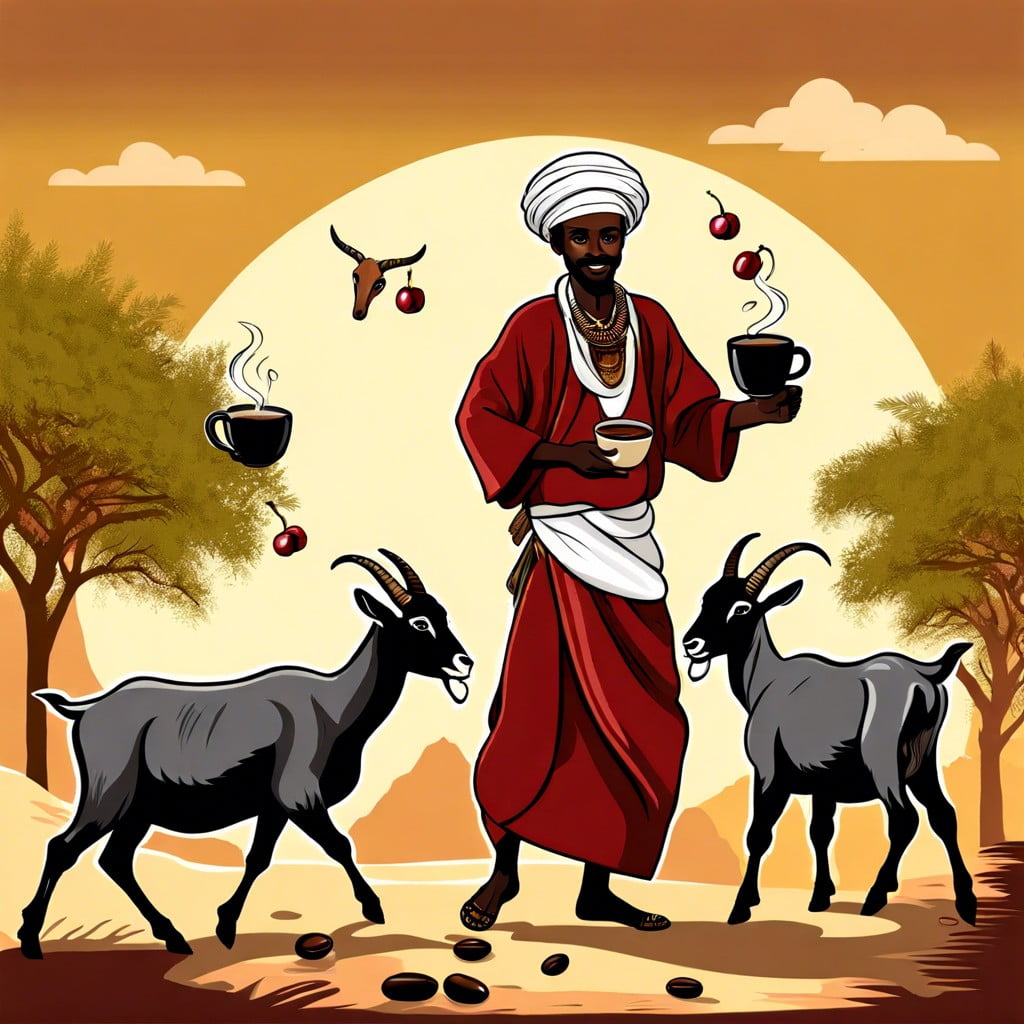Learn about the origins and global spread of coffee, from ancient rituals to modern-day coffee culture.
The Ethiopian Legend of Coffee Origins

According to folklore, coffee was discovered by a humble goat herder named Kaldi in the 9th century. Observing his goats frolicking energetically after eating berries from a certain bush, Kaldi tried them himself. The stimulating effect was immediate. Amazed by this discovery, Kaldi shared these berries with a monk in a nearby monastery. Initially skeptical, the monk tossed them into a fire, only to be enticed by the rich aroma of the roasting beans. They quickly learned to brew the beans, resulting in a drink that kept them awake and alert during long hours of prayer. Thus, the magic of coffee began to spread.
Coffee’s Journey From Ethiopia to Yemen
Arab traders brought coffee beans from Ethiopia to Yemen in the 15th century. There, Sufi monks began to cultivate the plant in their monasteries. They discovered that coffee could help them stay awake during their nighttime devotions. The method of roasting and brewing coffee as a drink was first recorded in Yemen, making it a crucial waypoint in coffee’s historical journey.
Soon, coffee became central to Yemeni culture and society. The port city of Mocha, which lent its name to the famous Mocha coffee, became a bustling trade hub for coffee. This port facilitated the spread of coffee across the Arabian Peninsula, setting the stage for its global voyage.
The Rise of Coffee Houses in Europe
The first European coffeehouse opened in Venice around 1645. With its exotic appeal, coffee quickly became a luxury item. By the late 17th century, coffeehouses had sprung up in major cities across England, Austria, France, Germany, and the Netherlands. Often referred to as ‘penny universities,’ a penny was the price of a cup of coffee and the admission to a place of stimulating conversation and debate.
These establishments played a pivotal role in the social and intellectual scene of the time. They served as a gathering spot for artists, writers, and intellectuals. Political discussions and business dealings were common amidst the aroma of freshly brewed coffee. London’s coffeehouses even gave rise to some of the world’s first financial institutions such as Lloyd’s of London, which started as a coffeehouse.
Thus, the introduction of coffeehouses marked a significant development in European social culture, fueling not just a caffeine addiction but also a fervor for lively intellectual exchange and commercial enterprise.
The Spread of Coffee Plantations Around the World
Coffee’s cultivation spread beyond Arabia in the 17th century when the Dutch began establishing plantations in Java, a trend soon followed in other parts of Asia such as Sumatra and Celebes. The Caribbean and Latin America saw the introduction of coffee in the 18th century, with the French planting it in Martinique and the Spanish in Central America. The favorable climate and vast tracts of land made these regions ideal for coffee cultivation, significantly boosting global supply.
As plantations proliferated, the economies of these regions transformed. Coffee became a major export commodity, influencing trade routes and colonial policies. The intensive labor required for coffee cultivation also had profound social implications, often relying on enslaved or indentured laborers. This period marked the beginning of coffee’s commodification and integration into global trade networks, setting the stage for its status as a staple in international commerce today.
The Modern Global Coffee Economy
The global coffee industry has grown into a powerhouse, influencing economies and cultures worldwide. Each year, millions of tons of coffee beans are traded on international markets, affecting both local farmers and major corporations.
- Economic Impact: Coffee stands as one of the most traded agricultural commodities in the world. Countries like Brazil, Vietnam, and Colombia are leading producers, with their economies significantly driven by coffee exports.
- Production Trends: Technological advancements have transformed coffee cultivation, making it more efficient but also raising concerns about sustainability and the environmental impact.
- Consumption Patterns: As coffee culture has evolved, so have the preferences and demands of consumers. Specialty coffees, with their emphasis on ethical sourcing and quality, are gaining popularity over traditional blends.
- Trade Dynamics: The market is largely influenced by the fluctuations in coffee prices on commodities exchanges. These variations can have a profound impact on the livelihoods of farmers in developing countries.
This expansive network not only fuels the economic engine in several parts of the world, but it also keeps the global populace caffeinated and culturally enriched.